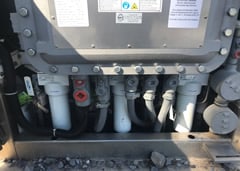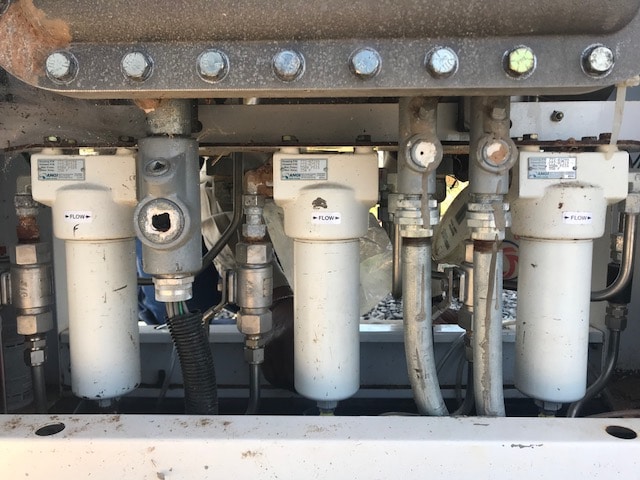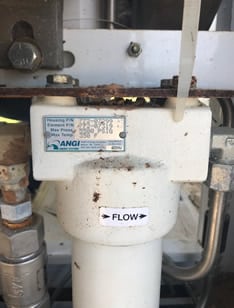By Annalloyd Thomason, Vice President/General Manager, NGVi
They are the most common performance complaints for heavy-duty natural gas vehicles:
- Hard to start
- Idles rough
- Hesitates under acceleration
- Low power
- Sometimes stalls
The most common culprit? Oil contamination in the fuel.

None of these components is inexpensive to replace, and if the technician doesn’t know what to look for or how to identify oil as the problem, thousands of dollars in parts can be replaced while the real problem remains unsolved: oil contamination in the fuel. NGVi recently worked with one small refuse fleet of 11 vehicles that has purchased just over $42,000 in coils, plugs and sensors in 15 months…all because of oil contamination in the fuel.
So why oil? At CNG fueling stations, compressors increase the pressure of natural gas to 3,600 psi or higher to allow adequate quantities of natural gas to be stored onboard vehicles. Compressors are extremely reliable pieces of equipment that require lubrication to operate properly. CNG fueling stations are designed with filtration systems to protect against oil “carried over” from the compressor into the fuel dispensed into vehicles, but for a variety of station maintenance reasons, many CNG stations still dispense oil.

Contaminated components will not function properly, and either the engine’s performance will suffer, or at the extreme, pistons will be damaged and the engine will fail.
So what’s a heavy-duty fleet manager to do? There are a few musts.
- To help reduce the amount of oil getting into vehicles, be sure to train drivers and/or fuelers to watch for oil in the fueling nozzle and receptacle. The best way to prevent oil problems in the vehicle is to never let it get there in the first place.
- Train technicians on the unique components of heavy-duty natural gas fuel systems and engines, how they function and how to diagnose them. This will allow your technicians to distinguish between a fuel problem, a fuel system problem or an engine problem. Nearly every week, NGVi works with clients who, prior to training, believed every problem they were experiencing was an engine problem when, in fact, many problems were associated with oil contamination.
- Excess oil in low pressure coalescing filters is the most significant early indicator of oil in the fuel stream. Heavy-duty fleets should include draining low-pressure coalescing filters as part of the daily driver pre- and post-trip inspections required by the Federal Motor Carrier Vehicle Safety Administration. Drivers should record the amount of liquid from the low-pressure filter daily on the DVIR, and if the amount exceeds about a tablespoon of liquid, report the condition to fleet maintenance and have it checked out. Early detection of oil in the low-pressure filter is the best way to ensure that the beginning of an oil carryover problem does not totally contaminate sensors and other engine components.
- Implement policies and training for drivers that require them to monitor for basic visible fuel system component integrity—especially dust covers on the fuel receptacles. Dust covers are not just nice little devices to make the receptacle look better—they are there to prevent d
- If you own and operate the CNG station that fuels your vehicles, make sure maintenance practicesare being followed precisely. Weekly draining of coalescing filters and ASME storage vessels at the station is essential and will alert station maintenance technicians to a potential problem. Coalescing filters are designed to remove liquid and aerosol oil and water from the CNG fuel stream. If you can see oil collected in the dispenser filter housings, either there is not enough filtration designed into the station or the filters are not being drained frequently enough. A pressure-drop indicator installed across one or more coalescing filters in series closest to the dispensers is the BEST way fueling station maintenance technicians can determine when it’s time to change filter elements.
- If your vehicles fuel at public sites, make sure the fuel provider guarantees fuel quality according to a specification that includes maximum water and oil content, among other variables. If the fuel provider can’t or won’t provide that fuel specification, find another fuel provider if at all possible.
Implementing these simple measures can help heavy-duty fleets save a lot of money and headache. Although they require effort on the front end, they are surely worth it because once oil is in the vehicles, it is extremely difficult (if not impossible) to eliminate, and can cause problems over the entire vehicle life.
If you’re experiencing a heavy-duty CNG engine performance problem or you suspect oil carryover in your fuel and would like technical assistance, contact us at 800-510-6484 or sdodd@ngvi.com.



